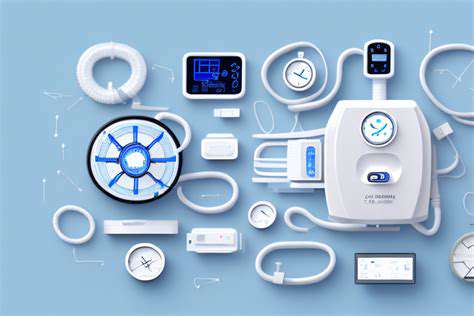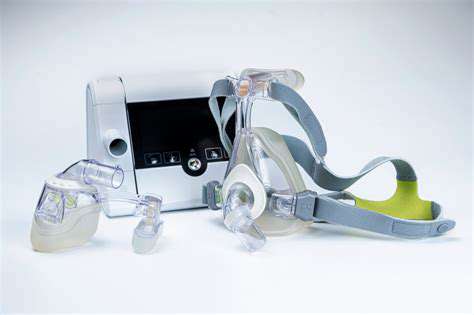Home CPAP Setup: Essential Tips for Effective Use
May 30, 2025 / zsfcdn103/

Setting Up Your CPAP Equipment Properly
Choosing the Right CPAP Machine
Selecting the right CPAP machine is crucial for a comfortable and effective sleep treatment. Consider factors like your desired pressure range, features such as built-in humidifiers, and the overall machine noise level. A machine that's too noisy can disrupt sleep, while a machine with insufficient humidification can cause dryness and discomfort. Research different models and read reviews from other users to help make an informed decision.
Different CPAP machines cater to various needs and preferences. For example, some machines offer adjustable pressure settings, allowing for personalized treatment. Others feature advanced diagnostic capabilities, enabling you to track your sleep data and adjust your treatment plan as needed. Ultimately, the ideal choice depends on your specific sleep apnea diagnosis and personal comfort level.
Mask Selection and Fit
Proper mask selection and fit are essential for optimal CPAP therapy. A poorly fitting mask can lead to discomfort, leaks, and difficulty breathing through the device. Different mask types, such as nasal pillows, full face masks, and nasal masks, offer varying levels of comfort and seal. Experiment with different mask types to find the one that best suits your facial structure and preferences.
Ensure that the mask fits snugly against your face, avoiding any gaps or pressure points. Proper mask positioning is critical to prevent air leaks and ensure effective treatment. If you experience any discomfort or difficulty breathing, adjust the mask or consult your doctor or a CPAP specialist for personalized guidance.
Setting the Correct Pressure
Setting the correct CPAP pressure is paramount for effective treatment. This pressure is tailored to your specific sleep apnea needs and is determined by a sleep study. The pressure setting is often displayed on the CPAP machine's control panel and should never be adjusted without consulting your healthcare provider.
Experimenting with pressure levels without medical guidance is highly discouraged. Incorrect pressure settings can lead to discomfort, ineffective treatment, and potential complications. Always adhere to the pressure prescribed by your doctor or sleep specialist to ensure optimal therapy and safety.
Humidification and its Importance
Humidification is a crucial aspect of CPAP therapy, especially for individuals experiencing dryness or congestion. Adding moisture to the air stream can significantly improve comfort and reduce nasal dryness. Many CPAP machines offer built-in humidifiers, but you might need an external humidifier for optimal results, depending on your machine and specific needs.
A well-humidified air stream can help prevent nasal dryness, sore throats, and other potential side effects. Proper humidification ensures a more comfortable and effective CPAP treatment experience. Consult your healthcare provider for recommendations on humidity levels suitable for your individual needs.
Troubleshooting Common Issues
Troubleshooting common CPAP issues is essential for maintaining consistent therapy. If you experience leaks, discomfort, or difficulty breathing, identify the root cause. Consider checking for proper mask fit, ensuring the pressure settings are correct, and making necessary adjustments to the machine's settings. If the problem persists, consult your doctor or sleep specialist for further guidance.
A common issue is air leaks. If you're experiencing leaks, carefully inspect the mask for any gaps or loose connections. A leak can lead to discomfort and ineffective treatment. If you cannot resolve the issue, seek professional advice.
Maintaining Your CPAP Equipment
Regular cleaning and maintenance of your CPAP equipment are essential to prevent the growth of bacteria and mold, and to ensure the longevity of your machine. Follow the manufacturer's instructions for cleaning the mask, tubing, and the machine itself. This includes using the appropriate cleaning solutions and techniques to prevent damage to the equipment.
Consistent cleaning helps maintain hygiene and prevents potential health risks. Proper maintenance extends the life of your CPAP equipment, reducing the need for replacements and ensuring the continuity of your sleep therapy. Regular cleaning also enhances the comfort and effectiveness of your CPAP treatment.
Mastering Mask Selection and Comfort

Choosing the Right Mask Material
Selecting the appropriate mask material is crucial for both comfort and effectiveness. Different materials offer varying levels of filtration and breathability. For example, a tightly woven fabric mask might offer better filtration but could feel less comfortable to wear for extended periods. Conversely, a softer, more breathable material might allow more air to pass through, potentially reducing filtration efficiency. Understanding these trade-offs is key to selecting the mask that best meets your needs.
Consider factors like the environment you'll be wearing the mask in. If you're working in a dusty or smoky area, a higher-filtration material like a N95 might be necessary. For everyday use in a less demanding environment, a well-fitted cloth mask might suffice. Carefully weigh the pros and cons of each material to make an informed decision.
Understanding Mask Fit and Seal
A properly fitted mask is essential for maximizing its effectiveness. A loose-fitting mask will allow air to leak around the edges, rendering the filtration less effective. This is a critical factor to consider, as proper sealing prevents the spread of airborne particles. Ensure the mask conforms snugly against your face, covering your nose and mouth completely.
Different mask styles have varying degrees of adjustability. Some masks may have ear loops that can be adjusted to fit more snugly, while others might utilize a head strap system. Experiment with different styles to find the one that best fits your face shape and provides a secure seal.
Importance of Mask Washing and Maintenance
Maintaining hygiene is paramount when using reusable masks. Regular washing and proper drying are essential to prevent the buildup of bacteria and viruses. Follow the manufacturer's instructions for cleaning and drying to ensure the longevity and effectiveness of your mask. Proper care helps keep the mask clean and ready for use.
The frequency of washing depends on the type of mask and how often it's used. Wash reusable masks after each use in hot water with detergent, and dry them completely before storing them. This simple preventative measure significantly reduces the risk of contamination.
Exploring Different Mask Styles and Types
A wide array of mask styles and types are available to cater to different needs and preferences. From simple cloth masks to more sophisticated N95 respirators, the choices are numerous. Consider factors like comfort, fit, and filtration efficiency when selecting a mask style.
Surgical masks, for example, are designed for single-use and offer a moderate level of filtration. Cloth masks come in various materials and designs, providing a more affordable and readily available option. N95 respirators, on the other hand, offer the highest level of filtration but require a proper fit to be effective.
Comfort and Long-Term Wear Considerations
Comfort is a significant factor when considering long-term mask use. A mask that's too tight or uncomfortable can lead to discomfort and reduced compliance. Choosing a mask that fits well and allows for adequate breathing is essential. Consider the material and design features that contribute to a comfortable fit. Proper ventilation is important to avoid overheating and moisture build-up.
Many masks include features like adjustable straps or ear loops for a customized fit. Consider the length of time you'll be wearing the mask, and choose a style that will minimize discomfort and maintain comfort throughout the day.
Establishing a Consistent CPAP Routine
Understanding the Importance of Consistency
Establishing a consistent CPAP routine is crucial for maximizing the effectiveness of your therapy. Regular use, adhering to your prescribed pressure settings, and maintaining a consistent sleep schedule all contribute to better sleep quality and improved overall health outcomes. Consistency isn't just about using your CPAP machine every night; it's about creating a reliable sleep environment that reinforces your body's natural sleep-wake cycle. Failure to maintain a consistent routine can lead to inconsistent results and potentially hinder the positive impact of CPAP treatment.
Consistency also plays a vital role in adjusting to the therapy. Your body needs time to adapt to the pressure and the new breathing pattern. A consistent routine allows your body to acclimate more effectively, minimizing discomfort and maximizing the benefits of CPAP. This adjustment period can vary from person to person, but a consistent approach promotes a smoother transition and helps you achieve the desired results.
Creating a Personalized CPAP Schedule
Developing a personalized CPAP schedule is a key element of a successful therapy routine. This involves considering factors like your typical sleep-wake cycle, work schedule, and any potential sleep disturbances. By understanding your individual needs and preferences, you can create a customized schedule that fits seamlessly into your daily life. This might involve setting specific times for putting on your CPAP mask and waking up, ensuring enough time for your body to adjust to the therapy.
Consider incorporating relaxation techniques into your pre-sleep routine to promote a calming atmosphere. Establishing a pre-sleep ritual, like taking a warm bath or listening to soothing music, can help signal your body that it's time to sleep. This can aid in better sleep quality and increase adherence to your CPAP routine.
Maintaining a Supportive Environment
Creating a supportive sleep environment is an important aspect of maintaining a consistent CPAP routine. A quiet, dark, and cool bedroom can significantly improve sleep quality. Reducing potential distractions, such as noise or light, can create an atmosphere conducive to relaxation and restful sleep. This supportive environment, combined with a consistent routine, enhances the efficacy of your CPAP therapy.
Furthermore, open communication with your healthcare provider is essential. Regular check-ins and discussions about any adjustments or concerns related to your CPAP routine are vital for optimal results. Your healthcare team can provide personalized guidance and support, helping you navigate any challenges and ensuring you're receiving the best possible care. This partnership between you and your healthcare provider is crucial for long-term success with CPAP therapy.
Having a supportive partner or family member can also make a big difference. Their understanding and encouragement can greatly assist in maintaining a consistent CPAP routine. Explaining the importance of the routine and the benefits of CPAP can help foster a positive and encouraging environment.
Maintaining Your CPAP System for Long-Term Efficacy

Cleaning Your CPAP Mask
Proper cleaning of your CPAP mask is crucial for maintaining hygiene and preventing the growth of bacteria and mold. Regular cleaning helps ensure a comfortable and healthy sleep experience. Failing to clean your mask regularly can lead to respiratory infections and other health issues. Thoroughly wash the mask components with warm, soapy water, following the manufacturer's instructions. Be sure to dry the mask completely before using it again to prevent mold and mildew buildup. Using a specialized CPAP mask cleaning solution can also enhance the process and maintain a fresher feeling.
Disassembling the mask for thorough cleaning is essential. This allows for deep cleaning of all crevices and nooks that may harbor bacteria. Once disassembled, each component should be washed separately and rinsed thoroughly with warm water. Pay particular attention to areas where moisture can accumulate, as these are prime breeding grounds for bacteria and fungi. Allowing the mask to air dry completely before reassembling it is essential to prevent any moisture buildup.
Maintaining Your CPAP Machine
Regular maintenance of your CPAP machine is vital for optimal performance and longevity. This includes checking the air filter for obstructions and replacing it as needed. A clogged filter can reduce airflow and impact the effectiveness of your therapy. Routine filter replacement ensures consistent pressure delivery and prevents potential damage to the machine. Also, check the tubing for any kinks or damage. Bent or damaged tubing can compromise the air delivery system, affecting the therapy's effectiveness.
Inspect the humidifier chamber regularly for any signs of mineral buildup. Mineral deposits can affect the machine's performance and cause a foul odor. Cleaning or replacing the humidifier chamber according to the manufacturer's instructions is important to maintain the optimal functionality of your CPAP machine. Additionally, ensure that the power cord is in good condition, free from damage, and properly connected to the machine and electrical outlet. This will prevent potential electrical hazards and ensure reliable operation.
Checking for Leaks and Proper Fit
Regularly checking for leaks in your CPAP system is important to ensure that you are receiving the prescribed air pressure. Leaks can significantly reduce the effectiveness of your therapy and negatively impact your comfort level. Conduct a leak test using the manufacturer-provided method or your healthcare professional's recommendations. Addressing leaks promptly can prevent discomfort and ensure consistent air pressure delivery.
Ensuring a proper CPAP mask fit is equally crucial for effective therapy. A poorly fitting mask can lead to discomfort, skin irritation, and leakage. Regularly check the mask's fit to ensure it conforms to your face and is positioned correctly. Adjust the mask as necessary to achieve a snug, comfortable seal. Contact your healthcare professional or a trained CPAP specialist if you experience any discomfort or difficulty with the mask fit.